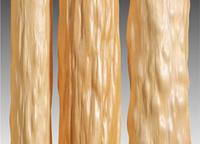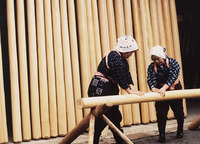

Total:131items
- Pottery & Porcelain (18)
- Lacquerware (4)
- Glasswork (2)
- Wood & Bamboo Work (19)
- Hakone Yosegi Zaiku: Hakone Marquetry
- Boshu Uchiwa: Boshu Fans
- Nikko-bori: Nikko carving
- Sasebo Koma (Sasebo Spinning Top)
- Shimoda Yanimatsu Zaiku (Shimoda Joinery of Oily Pine)
- Echizen Takeningyo (Bamboo Dolls)
- Osaka Senshu Kiri-dansu: Paulownia chest of drawers or wardrobes of Senshu, Osaka
- Kitayama Maruta: Japanese cedar logs
- Yodoegasa: Yodoe umbrella
- Atami Kusu Zaiku: Atami Camphor wood crafts
- Kawatsura Kokeshi Doll
- Itaya Zaiku: Itaya Bark Craft
- Yokohama Classic Furniture
- Hinaga Uchiwa: Hinaga Fan
- Torafu Takezaiku: Tiger Bamboo Work
- Tsuruzaiku: Woven Vine Craft
- Okawa Kumiko: Okawa Kumiko Wood Joinery
- Shuro Houki: Hemp-palm Broom
- Furyumen: Wood Carving Mask
- Leather Work (1)
- Papermaking (13)
- Textile (20)
- Dyeing products (5)
- Masonry (1)
- Metal Work (11)
- Stationery (4)
- Livingware (3)
- Accessory (4)
- Toys & Entertainment (14)
- Interior (2)
- Other crafts (10)

 |
Main Production Site:Kyoto |
 《Characteristics》
《Characteristics》Kitayama Maruta is a generic name of cedar logs cut and proceeded in Kyoto that includes polished round logs, artificially and naturally striated logs, menkawabashira (wood with four planed sides but retaining natural texture) and rafters. Their special characteristics are a fine wood, a velvety and lustrous surface, and a resistance to drying and cracking. Also, in comparison with manufactured products and general types of logs, Kitayama Maruta provides excellent bending properties.
This refined quality of Kitayama Maruta makes perfect harmony in both traditional Japanese-style architecture and modern architecture. The tasteful logs are used in interior space as a nature's gift which makes us feel like being back in the nature. A multifarious and unfading beauty of its appearance will attract anyone who sees it.
Kitayama Maruta, tradiotional craftwork of Kyoto which has a history of 600 years, is designated as " Traditional Craftworks of Kyoto Prefecture" and "Traditional Craftworks Industrial Products of Kyoto City" .
Below is the feature of Kitayama cedar depicted in "Shirasugi Kitayama Maruta Buyo-Ho (How to cultivate Kitayama Maruta)" (written by Daisuke Kusakabe in 1899.)
"Shirasugi Kitayama Maruta (Logs of "White Cedar" which is one of the species of Kitayama Cedars) used as alcove posts standing straight with no distortion in the center of the main temple .
Its high wood density gives hardness to the body,
Its surface is shining white like a snow ,
On the perfect cylindrical body from the top to the bottom,
no knot nor scar can be found.
There is no doubt that Shirasugi Kitayama Maruta is admired as the most elegant and superb quality in the world.
By careful cultivating method, such as repeated pruning,Kitayama Maruta has a special nature that is different fromthe logs of other forestry regions.
《Types of Kitayama Maruta》
Kitayama Migaki Maruta (Polished log )
This is a basic process for Kitayama Maruta products. Logs which have no knob or knot on the surface are finished with this simplest process. The feature of the products is smooth and lustrous wood surface. Also its appearance is evenly cylindrical with minor difference on both ends of the log.
Kitayama Tennen Deshibori Maruta (Logs with natural convexity)
This type of logs originally has knobs and wavelike unevenness (striations) called "Shibori" on the surface, which is mainly used as alcove posts in Japanese rooms. The unique appearance is made through the growing conditions, such as the nature of the soil or sun exposure . Also the convexity patterns vary according to the species.
Kitayama Chirimen Shibori Maruta (Logs with natural striation)
This is another type of logs which has natural striation. While above type of logs has knobs or unevenness protruding on the surface , this type is characterized by long narrow recesses onthe surface, which is extremely rare.
Artificially Striated Kitayama Maruta
Logs are processed with artificial striation on the wood surface .
Kitayama Rafters (small logs)
Small Kitayama Maruta is used as rafters. Due to its plain surface and no size difference on both ends, it is generally used for tearooms and tea houses. Recently, it is also used for handrails or decorations on buildings such as louvers. .
Kitayama Menkawabashira (Polished logs with four planed sides )
This is a type of logs madefrom polished Maruta. Four sides of the log are planed with an adze or similar tools. Natural beauty of the wood itself and the wood grain after planing can be enjoyed at the same time.
[Traditional Handicrafts of Koto Prefecture], [Traditional Craftworks Industrial Products of Kyoto City]
Source: Kyoto Kitayama Maruta Cooperative Association
Translation: Marie Mine, reviewed by Naoko Yamashita

| Materials | Wood |
|---|---|
| Crafting Processes | Manufacturing process of Kitayama Maruta
【1】Picking shoots for grafting Picking ears of a shoot at the length of 30cm from a parent tree and plant it on a seedbed. 【2】Transplanting Two years after grafting, well-rooted young plants are transplanted in a mountain. 【3】Undergrowth mowing Six or seven years after transplanting, undergrowth mowing are done between June and August every year. 【4】Offshoots removal This is a very important process to produce fine Kitayama Maruta. The first pruning is done after six or seven years from the transplanting and the process needs to be repeated every four years after the first pruning. What is important in this process is to remove offshoots from the base on the trunk so that unnecessary branch will not come out after this process. 【5】Emboss processing (only for Artificially Striated Maruta) Artificially striated Maruta is made through emboss processing, which is mainly used for alcove posts in Japanese rooms. Concavity and convexity patterns are made by plastic braces like chopsticks. Plastic braces are fixed with wires on young trees and the patterns are carved on trunks after a couple of years. 【6】Pruning Trees need to be pruned in winter just before the year of logging This is to keep the size that the trees have grown by winter. This process makes firm woodgrain, and gives anti-cracking effect as well as lustrous colors on the surface. 【7】Lumbering and shipping Trees are cut down and dried naturally for about one month. After that, logs are trimmed and shipped. 【8】Stripping bark and back boundary The bark of the shipped logs is stripped. To protect the surface of the logs from drying and cracking, one side of the log is sawed with a round saw to the core (back split). 【9】Sun drying After back boundary process is provided, logs are dried in the sun. When the wood surface turns white, the logs are naturally dried in a well ventilated room. It takes from one to three weeks depending on climate. 【10】Artificial drying (by machine) After sun drying, logs are artificially dried by machine. 【11】Polishing To make more lustrous surface, logs are polished with a tool like a scrubbing brush. 【12】Finished products These painstaking care and processes continued for approximately 30 years made itssmooth surface and uniqueglaze on polished logs of Kitayama Maruta. |
| History | It is said that the origin of Kitayama Sugi (Japanese cedar) stretches back 600 years ago. And the first Kitayama Maruta was produced during the Ouei era (1394 to 1427) in Muromachi period. Later the logs were frequently used for tearooms and tea houses which represents "Cha-no-yu (tea ceremony)" culture completed by Sen-no-Rikyu. Producing method of Kitayama Maruta has been handed over time over time until now. And consistent policy of silviculture and processing techniques which our predecessors cultivated through the persistent efforts and wisdom have been taken over to us, Kitayama Maruta logs were originally used as design materials, for alcove posts or tea rooms rather than used as general wood materials of houses because of its unique patterns and luster on the surface. However, in recent years, Kitayama Maruta is getting more attention as a construction material.
|
| Related URL | http://www.kyotokitayamamaruta.com/index.html |
◆Exhibition / Showcase
Kyoto Kitayama-Sugi-no-Sato Comprehensive Center
Open 9:00~17:00
Irregular holidays
74 Nakagawa-Kawato, Kita-ku, Kyoto City, 601-0125
TEL +81-(0)75-406-2212 FAX +81-(0)75‐406‐2823
(Japanese only)
◆Event Information
Training course and experience training are available.
Click here for more information.
Assistance needed? For inquiries in English:
JTCO Contact Form
Your inquiries will be forwarded by JTCO in Japanese to the organization you wish to contact.



